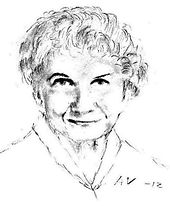Amundsen (short story)

Amundsen is a short story by Alice Munro from 2012, which is about one-sided hypothermia in a relationship and its unclear end.
content
In order to earn money after graduating from university, Vivien Hyde, the first-person narrator, takes a job as a teacher in a tuberculosis sanatorium for children in winter. To do this, she drives to a place called Amundsen in the Canadian province, which is inhabited by loggers and is located on a frozen lake. In the gloomy sanatorium, there is an oppressive atmosphere full of taboos and unexplained circumstances in view of the terminally ill children, some of whom are threatened with death.
The prospective teacher is warned urgently about a cold; further tips and advice are inevitable. The doctor in charge, Alister Fox, has a brief interview with her, during which there is a short sparring on topics from world literature. The "doctor", as he is usually called in the course of the story, gives her brief instructions on her lessons, including: a. the request not to upset the children too much - for medical reasons - and still fight their boredom.
The students soon realize that it is just a pretend school that is not about grades. Classes only take place in the mornings and only those schoolchildren who are healthy enough to take part take part. When Vivien is off in the afternoons, she sometimes goes to Amundsen to eat. One teenager, Mary, whose mother runs the sanatorium's kitchen and goes to school in town, is a very lively guy. Occasionally she keeps the narrator company and tells about her childhood, which means Vivien learns a little more about the doctor.
One evening, Miss Hyde is invited to dinner with her hypothermic manager for the second time when Mary bursts in and performs a song number from the play that the two adults purposely missed out on local performance. Alister Fox brings Mary home to safely get rid of her. An affair between the teacher and the doctor had already begun and had been continued in the style of a knowledge sparring before Mary appeared, including the characters Naphta and Settembrini from Thomas Mann's Magic Mountain . That same evening the affair was sexually sealed and a few weeks later it suddenly ended while driving a car, when the doctor decided against marriage despite his announcement and specific preparations. That afternoon he buys his lover a train ticket to Toronto and has her things forwarded. After boarding Vivien, she meets a group of young people, including Mary, who greets her with a storm. She excuses herself with an untruth and does not explain to Mary about her hasty departure and the reason for it.
The last section tells of a reunion years later, in which Vivien meets her former lover in the middle of the turmoil of a street crossing in Toronto, they exchange a few words and part in different directions. The first-person narrator perceives his peculiarly nervous left eye again. It remains to be seen whether this relationship will end.
interpretation
In an interview on her latest band, Dear Life , Alice Munro said: The young woman is having her first experience with a man who is hopelessly selfish. He is the type of man they are interested in, a price that is always worthwhile. In the end, the woman became more realistic and kept him in her imagination. That is their point of view.
Editions and versions
Amundsen is included in Dear Life (2012), Alice Munro's fourteenth and most recent collection of short stories, published in 2013 with the title Liebes Leben in German. In the volume Dear Life , Amundsen has a length of 34 pages in English. The story was also published in the August 27, 2012 issue of The New Yorker and can be read online free of charge.
The two versions have 15 sections each, but the magazine version is shorter overall than the book version. A section is swapped between the versions: The written introduction to the job, which makes up the second section in the magazine version, is the third section in the book version and, conversely, the third section of the book version is the second section of the magazine version. Furthermore, a section change is added once and one is deleted once. In the book version, a new section begins with “The key to his house showed up on the floor of my room, slipped under the door when I wasn't there.” In the magazine version, these lines are at the end of the seventh section. The erased section change can be found in the magazine version between sections 12 and 13, where at the end of the twelfth section the couple walk hand in hand to the car to continue their journey to the location of the marriage ceremony. After "settles himself and turns the key in the ignition, then turns it off", there is no change of section in the book version.
In addition to linguistic and stylistic changes, the two versions differ in that the first-person narrator in the book version occasionally remembers growing up with her grandparents. A difference can also be made out for the last sentence of the story: In the book version it says "Nothing changes really about love." In the magazine version it says: "Nothing changes, apparently, about love."
Individual evidence
- ↑ Alice Munro: On Dear Life . An Interview with Alice Munro , The New Yorker , November 20, 2012
- ↑ Web link to free version of the story
Web link
- Summary with comments on "Amundsen" (in English) , mookseandgripes.com , August 20, 2012 f.
